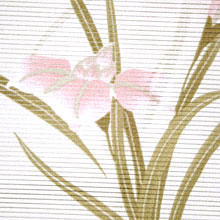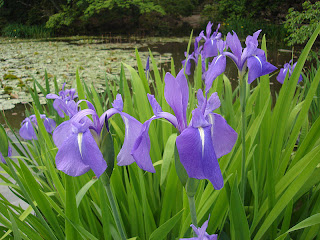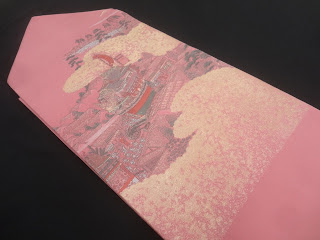Here we are with the month of May, my birth month actually. :) In olden times, the months had different names than the simple ones they do now (Fifth Month, Sixth Month, etc.). May's old name was Satsuki ("the month of growing things"), and is also used as a girl's name.
(If you're looking to buy kimono, I recommend Rakuten for new ones, especially casual wear, and Ichiroya for nice vintage ones!)
for new ones, especially casual wear, and Ichiroya for nice vintage ones!)
The Month of May
Patterns
Peony (botan), flowering dogwood (hana-mizuki), flowers and birds, young bamboo (waka-take), seasonal scenery, gradated patterns, and a mix of scattered nature and court patterns.
Patterns Associated with May
Flower raft (hana-ikada), both the nock/fletching of an arrow (yahazu or yabane) and armor (yoroi) due to Boys’ Day being in May, hollyhock (aoi) patterns due to Kyoto’s famous Hollyhock Festival (Aoi Matsuri) in May, carriages (mi-kuruma), parade floats (dashi).
Original Author Notes
Regarding lined kimono for “furo” (portable stove for boiling water used for summer tea ceremonies):
Translator Notes
Nothing special this month.
(Notes below repeated from previous months)
(If you're looking to buy kimono, I recommend Rakuten
The Month of May
Kimono
Kimono are lined. Fabrics include kotoshi chirimen or kawari chirimen, and for woven things mon-ishou silks (single-color fabrics woven with patterns in the background) are used. Rinzu silks feature refreshing patterns like flowing water or streams (ryuu-sui), waves (nami), running bamboo (sasa), or a mix of scattered nature and court patterns (go-sho-doki).
Kimono are lined. Fabrics include kotoshi chirimen or kawari chirimen, and for woven things mon-ishou silks (single-color fabrics woven with patterns in the background) are used. Rinzu silks feature refreshing patterns like flowing water or streams (ryuu-sui), waves (nami), running bamboo (sasa), or a mix of scattered nature and court patterns (go-sho-doki).
Colors are bright
tones while reflecting the season. With dyed patterns, it’s good to go with
things like flowers that bloom in the beginning of summer, general evergreen
plants (toki-wagi), seasonal scenery (fuu-kei), and dyed gradations.
For the first part of
the month, wear lined kimono. Starting in the middle of the month, things like
kimono that are unlined on the body part, lined “ro (gauze)”, and lined “sha (gauze)” silks can
be worn to stylishly hint at the coming season.
Obi
This month, brocade-weave (nishiki-ori) fukuro obi use the same materials as spring obi, but through colors and patterns it’s good to give a sense of summer drawing near.
This month, brocade-weave (nishiki-ori) fukuro obi use the same materials as spring obi, but through colors and patterns it’s good to give a sense of summer drawing near.
Rather than
multicolored obi, go with monochrome or something like gold/silver brocade to
create a cool brilliance. Other than things like tapestry-weave obi (tsuzure), for
more lightweight wear you can use shioze or habutae silk obi painted with
seasonal designs, or chirimen silk Nagoya obi with dyed patterns.
In the case of lined
ro or sha kimono, a medium-weight summer obi is a good match.
Accessories
Obiage and obijime are similar to spring ones, but the colors and patterns are brighter, losing their darker and more muted tones. Obiage are lightweight chirimen or rinzu. Obijime types include narrow maru-kara-gumi, kanze, or yurugi.
Obiage and obijime are similar to spring ones, but the colors and patterns are brighter, losing their darker and more muted tones. Obiage are lightweight chirimen or rinzu. Obijime types include narrow maru-kara-gumi, kanze, or yurugi.
Naga-juban are hitoe:
choose light colors featuring things like summer flower patterns or gradation.
Collars are shioze
habutae, tabi are lined white calico, and footwear is enamel (vinyl) in light
colors.
Colors
Use tones, which are highly saturated colors mixed with neutral ones to dull them and make them softer. Examples include light purple (asa-murasaki) C4A3BF, wisteria purple (fuji-iro) AFB4DB, grey-pink (hai-zakura) E6D2C9, light blue (mizu-iro) AFDFE4, celadon (seiji-iro) 60B49F, and turquoise blue (toruko-buru) 40E0D0.
Use tones, which are highly saturated colors mixed with neutral ones to dull them and make them softer. Examples include light purple (asa-murasaki) C4A3BF, wisteria purple (fuji-iro) AFB4DB, grey-pink (hai-zakura) E6D2C9, light blue (mizu-iro) AFDFE4, celadon (seiji-iro) 60B49F, and turquoise blue (toruko-buru) 40E0D0.
Patterns
Peony (botan), flowering dogwood (hana-mizuki), flowers and birds, young bamboo (waka-take), seasonal scenery, gradated patterns, and a mix of scattered nature and court patterns.
Flowers Associated with May
Paulownia (kiri), bitter orange (tachibana), lily (yuri), green maple leaves (ao-kaede), Japanese iris (hana-shoubu), rabbit-ear iris (kakitsubata), Siberian iris (ayame), pear flower (nashi-no-hana), bamboo (take) specifically young bamboo, deutzia crenata (u-no-hana), gymnaster savatieri (miyako-wasure).
Paulownia (kiri), bitter orange (tachibana), lily (yuri), green maple leaves (ao-kaede), Japanese iris (hana-shoubu), rabbit-ear iris (kakitsubata), Siberian iris (ayame), pear flower (nashi-no-hana), bamboo (take) specifically young bamboo, deutzia crenata (u-no-hana), gymnaster savatieri (miyako-wasure).
 |
| Green maple leaves |
 |
| Various irises |
 |
| Pear flower |
See previous section for bamboo.
 |
| Deutzia (crenata) |
 |
| Gymnaster savatieri |
Patterns Associated with May
Flower raft (hana-ikada), both the nock/fletching of an arrow (yahazu or yabane) and armor (yoroi) due to Boys’ Day being in May, hollyhock (aoi) patterns due to Kyoto’s famous Hollyhock Festival (Aoi Matsuri) in May, carriages (mi-kuruma), parade floats (dashi).
Original Author Notes
Regarding lined kimono for “furo” (portable stove for boiling water used for summer tea ceremonies):
May is the season of
bright green (plants). With the passing
of the 5th, the first day of summer, tea ceremony marks the boundary
between spring and summer by switching out the hearth for the portable “furo”.
 |
| "Furo", the portable hearth |
The tatami mat that
replaces the hearth, fresher and greener than the mats around it, heightens the
newness that comes with the first tea ceremony of the year to use the “furo”
rather than the hearth.
May kimono are lined.
Take care to use utensils and arrange the room in a summer-like fashion. Also,
remember that winter and spring kimono give a different feeling than summer
ones. Avoid creating a heavy look by choosing fresh colors, light fabrics, and
simple designs.
The beauty of a kimono
lies in its colors and patterns, but how it fits with the obi chosen can also
change the impression it gives. While May and October obi like dyed obi and
such are light to begin with, we also want their patterns and materials to give
a sense of the season. White obi with painted flowers like peony, iris, green
maple leaves, wisteria (fuji), and clematis (tessen) might be good for a light
feeling.
 |
| Wisteria |
 |
| Clematis |
Also, it’s a popular
season for “open-air” tea ceremonies. On days where you’re likely to sweat,
it’s good to wear “dou-bitoe” kimono. “Dou-bitoe”, or “chest-single-layer”
kimono are kimono where the bottom half, back sleeve edge, and sleeve cuff edge
are lined, leaving the chest area and sleeves unlined. When worn, dou-bitoe
look like regular lined kimono.
 |
| A dou-bitoe kimono |
From mid-month on,
naga-juban change over to ro and collars become shioze as more ways to dress
cooler.
With things like sha lined
kimono, even if they get a little water on them they won’t shrink so they’re very
handy for long trips or time spent in the “mizu-ya”, the room next to the tea
ceremony room where utensils are washed. Even though they’re made of sha,
because they are sewn as lined kimono there is no problem (I believe the author
means there is no problem with the formality level).
Translator Footnotes
Nothing special this month, but yes, I did use Date replica armor for the armor picture. Go Sendai! XD
Nothing special this month, but yes, I did use Date replica armor for the armor picture. Go Sendai! XD
Translator Notes
Nothing special this month.
(Notes below repeated from previous months)
-The original author repeats several points, so with certain common terms I am using the Japanese name on first mention only. If you’re unsure of something, feel free to ask and I can clarify.
-The number next to the color name is that color's hex code as used in HTML. Keep in mind the exact shade may vary as well, from what I've seen cross-checking traditional color-name sites with actual kimono vendors.
-The number next to the color name is that color's hex code as used in HTML. Keep in mind the exact shade may vary as well, from what I've seen cross-checking traditional color-name sites with actual kimono vendors.
- As a note, this is my translation of a tea ceremony kimono site. The tea ceremony world, I have learned, is among the strictest when it comes to following proper seasonality rules, so bear in mind that these rules are more stringent than the general thinking for daily and casual kimono wearers.
It’s great if a daily wearer can put together an outfit following all of these rules, but very few will look at you funny if you can’t, as it’s hard and can be expensive to collect all the proper pieces. I’m translating this site more as part of my efforts to add to the world of English-language kimono information for those who don’t speak Japanese.
It’s great if a daily wearer can put together an outfit following all of these rules, but very few will look at you funny if you can’t, as it’s hard and can be expensive to collect all the proper pieces. I’m translating this site more as part of my efforts to add to the world of English-language kimono information for those who don’t speak Japanese.








































































